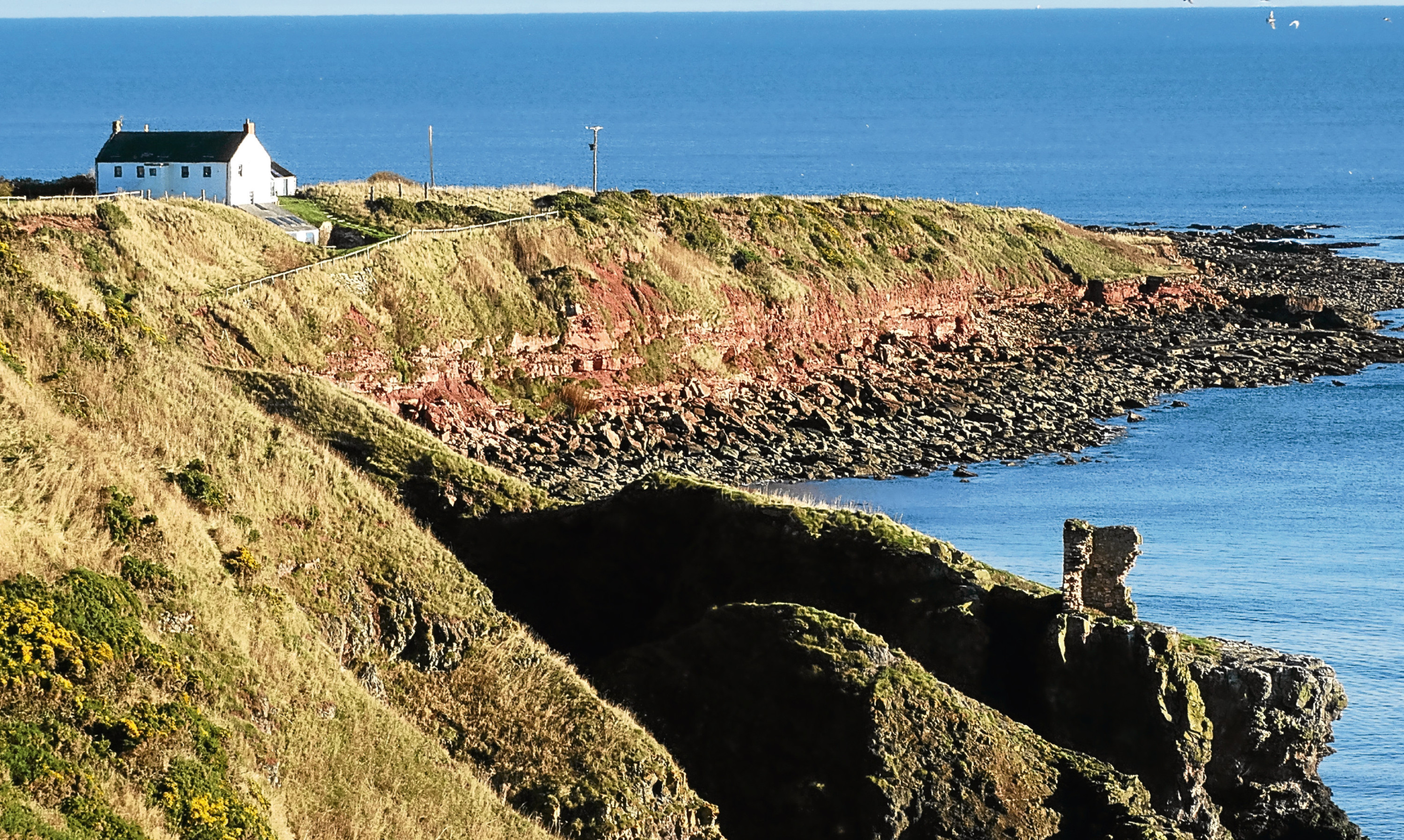Last Sunday I took a walk with Inka which I had been intending to do all summer. I chose the best day, for it was sunny and mild.
I headed for St Cyrus Parish Church and the track leading to the clifftop walk. There’s a small parking area for half a dozen cars and from it a magical panorama stretches up and down the coast which fair lifts the spirits on a fine day.
On the way I saw two coveys of our native grey partridge feeding in stubble fields, which is notable in itself as our native species have been in decline for the last 40 years and are now on the RSPB red endangered list. For me they are one of our countryside’s most attractive and endearing birds.
Inka and I set off up the coast for I wanted to see what little, if anything, still remains of the ruins of the Kaim of Mathers, sometimes dramatically referred to as the Cannibal Laird’s Castle. It has a gruesome tale attached to it going back to 1420.
Medieval picnic
The arrogant Sheriff John Melville of Glenbervie, Sheriff of the Mearns, had long angered the principal lairds in the district with his high-handed and autocratic application of the law.
The lairds repeatedly complained of their exasperation to the King, James I, who in a moment of unguarded impatience burst out “Sorrow gin that sheriff were sodden and suppit in broo”, meaning that for all he cared they could boil the sheriff and make soup of him.
Acting on that doubtful authority, Barclay of Mathers, along with the lairds of Lauriston, Arbuthnott, Pitarrow and Halkerton, invited the sheriff to join them on a hunting party in the Forest of Garvock on the east side of the Hill of Garvock, across the hill from the town of Laurencekirk.
In the 15th Century the area was heavily wooded and the Sheriff was lured to a secluded spot in the forest – “a retired place” – where he was struck down, stripped naked and thrown into a huge boiling cauldron, or “kettle”.
After he was boiled, or “sodden”, it is said that each of the conspirators compounded the barbarity of their deed and “suppit” a spoonful of the “broo”. Or, as a later historian described it, the conspirators “concluded the scene of abomination by actually partaking of the hell broth”.
Royal revenge
The king denied any involvement in the sheriff’s murder, refusing to acknowledge that he had sanctioned the lairds’ actions and denouncing them as outlaws.
Barclay of Mathers was singled out as ringleader for special condemnation and the king laid a curse on him that, for the rest of his life, he should get no peace to live either on land or sea.
To escape the king’s further vengeance, Barclay built a stronghold called the Kaim (fortress or castle) of Mathers on an almost inaccessible sea stack described as “poised between the land and sea” on the cliff face at the north end of St Cyrus Bay, thus frustrating the king’s curse and where, it is said, he lived out the rest of his life “quite secure”.
A stump of a tower clinging to the cliff is all that remains of the castle, the rest having succumbed to the ravages of the North-East weather.
The woodland gully where the ill-starred sheriff met his grisly end is remembered locally as the Sheriff’s Kettle or Shirra’s Pot. The unremarkable wee gully, with a ribbon of a burn running through it – handy for filling kettles! – gives no hint today of its horrible history.
The Kettle is on the farm of Browniesleys and both are shown on the Ordnance Survey map. The farm is supposedly so named because the area is haunted by brownies, the countryside spirits.
The Kaim of Mathers reminds me of Fast Castle in Berwickshire and Findlater Castle on the Moray Firth, rocky eyries built on inaccessible and almost impregnable seashore promontories. And, like the Kaim, both have colourful histories of murder and bloodshed.
Inka had a marvellous run in the stubbles and hunting through the thick gorse that covers the cliff top, putting up two pheasants.
I found a sheltered spot and sat looking at the blue sea and sky meeting on a far horizon and listening to the gentle susurration of the tide breaking on the shore below me. I remembered childhood walks and beach picnics when my father parked our caravan in a field across from the church for short Easter holidays.
Turning to walk back to the car the low winter sun was positively bouncing off the sea. The spire of the parish church, high on the Brae Heads, once a valuable navigation mark for mariners and a fishing mark for the inshore fishermen, has been superseded by modern satnav systems. But the view down St Cyrus Bay, along Montrose Bay and on to Red Head at the southernmost limit of Lunan Bay is as unchanging and bonny as ever.
Then it was home for a bowl of the Doyenne’s home-made soup to finish off an altogether satisfactory morning.
